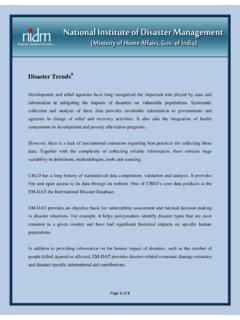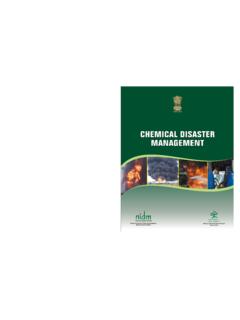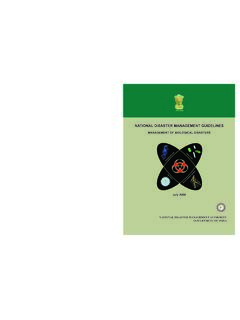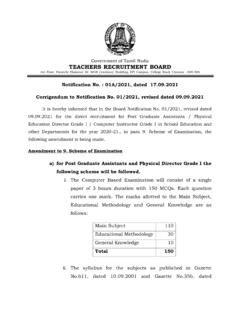Transcription of DISASTER MANAGEMENT FOR SCHOOL STUDENTS
1 National Institute of DISASTER ManagementMinistry of Home Affairs, Government of India5-B, IIPA Campus, IP Estate, Mahatma Gandhi Marg, New Delhi-110 002 ISBN 978-93-82571-05-6 ACTIVITY BOOK ONDISASTER MANAGEMENT FOR SCHOOL STUDENTSN ational Institute of DISASTER ManagementMinistry of Home Affairs, Government of India5-B, IIPA Campus, IP Estate, Mahatma Gandhi Marg, New Delhi-110 002 Vigyan Prasar(Deptt. of Science & Technology, Government of India)C-24, Qutub Institutional Area, New Delhi-110016 (India)by:Surya ParkashIrfana BegumRitaACTIVITY BOOK ONDISASTER MANAGEMENT FOR SCHOOL STUDENTSISBN: 978-93-82571-05-6 EDITION - 2014 Published by:National Institute of DISASTER MANAGEMENT ,Ministry of Home Affair, New Delhi Citation-Parkash Surya, Irfana Begum, and Rita (2013). Activity Book on DISASTER MANAGEMENT for SCHOOL STUDENTS . National Institute of DISASTER MANAGEMENT , New Delhi - 110002, Pages and Printing-Chandu Press, D-97, Shakarpur, Delhi-92 ACTIVITY BOOK ON DISASTER MANAGEMENT FOR SCHOOL STUDENTSA uthors: Surya ParkashIrfana Begum RitaVIGYAN PRASAR(Deptt.)
2 Of Science & Technology, Govt. of India)C-24 Qutab Institutional Area, New Delhi - 110016 (India)NATIONAL INSTITUTE OF DISASTER MANAGEMENT (Ministry of Home Affairs, Govt. of India),5-B, IIPA Campus, IP Estate, Mahatma Gandhi Marg, New Delhi - 110 002 (India)2 Vigyan Prasar (VP) is an autonomous organization under Department of Science and Technology. Objectives of VP are to take up large-scale science popularization tasks/activities, to promote and propagate scientific and rational outlook, to act as a resource-cum-facility centre for S&T was established in : To promote and propagate scientific and rational outlook. To act as a resource-cum-facility centre for S&T communication. To take up large-scale science popularization tasks/activities. To develop, disseminate and market a variety of software on S&T popularization in different Indian languages (Audio, Video, Radio, TV, Print, Learning packages, Kits, Toys).
3 Using different media for S&T Communication. Use of new/emerging technologies for S&T Prasar - A Resource-Cum-Facility Centre VP is a national resource-cum-facility centre for S&T communication VP strives to adapt, utilize and employ new and emerging technologies for S&T communication/ popularization. VP s emphasis is on development, production, dissemination and marketing of S&T software. VP s emphasis is on development of a countrywide network for S&T popularization / communication. VP organizes training programmes on use and dissemination of software Institute of DISASTER MANAGEMENT (NIDM) The National Institute of DISASTER MANAGEMENT constituted under the DISASTER MANAGEMENT Act 2005 has been entrusted with the nodal national responsibility for human resource development, capacity building, training, research, documentation and policy advocacy in the field of DISASTER : To be a premier Institute of Excellence for training and research on DISASTER risk mitigation and MANAGEMENT in India and to be recognized as one of the leading Institutions at the international level in this field.
4 To strive relentlessly towards making a DISASTER free India by developing and promoting a culture of prevention and preparedness at all : To work as a think tank for the Government by providing assistance in policy formula-tion and To facilitate in reducing the impact of disasters through Planning and promot-ing training and capacity building services including strategic learning. Research, docu-mentation and development of national level information base. System development and expertise promotion for effective DISASTER preparedness and mitigation. Promoting awareness and enhancing knowledge and skills of all stakeholders. Strengthening insti-tutional mechanisms for training and capacity building of all stakeholders at all levels. Networking and facilitating exchange of information, experience and :Under the DISASTER MANAGEMENT Act 2005, the Institute inter alia, has been entrusted with the following functions: develop training modules, undertake research and documentation in DISASTER MANAGEMENT and organize training programme, formulate and implement a comprehensive human resource development plan covering all aspects of DISASTER MANAGEMENT ; provide assistance in national level policy formulation; provide required assistance to the training and research institutes for development of training and research programmes for various stakeholders; provide assistance to the State Governments and State training institutes in the formulation of State level policies, strategies, DISASTER MANAGEMENT framework and any other assistance as may be required for capacity-building.
5 Develop educational materials for DISASTER MANAGEMENT including academic and professional courses; promote awareness among stakeholders including college/ SCHOOL teachers and STUDENTS , technical personnel and others associated with multi-hazard mitigation, preparedness and response measures; undertake, organize and facilitate study courses, conferences, lectures, seminars within and outside the country to promote DISASTER MANAGEMENT ; undertake and provide support for publication of journals, research papers and books and establish and maintain libraries means a catastrophe, mishap, calamity or grave occurrence in any area, arising from natural or man made causes, or by accident or negligence which results in substantial loss of life or human suffering or damage to, and destruction of, property, or damage to, or degradation of, environment, and is of such a nature or magnitude as to be beyond the coping capacity of the community of the affected area (definition according to DISASTER MANAGEMENT Act 2005, Government of India)HazardA dangerous phenomenon, substance, human activity or condition that may cause loss of life, injury or other health impacts, property damage, loss of livelihoods and services, social and economic disruption, or environmental damage.
6 Hazards arise from a variety of geological, meteorological, hydrological, oceanic, biological, and technological sources, sometimes acting in combination. In technical settings, hazards are described quantitatively by the likely frequency of occurrence of different intensities for different areas, as determined from historical data or scientific analysis. Natural hazardNatural process or phenomenon that may cause loss of life, injury or other health impacts, property damage, loss of livelihoods and services, social and economic disruption, or environmental damage. Natural hazards are a sub-set of all hazards. The term is used to describe actual hazard events as well as the latent hazard conditions that may give rise to future events. Natural hazard events can be characterized by their magnitude or intensity, speed of onset, duration, and area of extent. For example, earthquakes have short durations and usually affect a relatively small region, whereas droughts are slow to develop and fade away and often affect large regions.
7 In some cases hazards may be coupled, as in the flood caused by a hurricane or the tsunami that is created by an hazardsA hazard originating from technological or industrial conditions, including accidents, dangerous procedures, infrastructure failures or specific human activities, that may cause loss of life, injury, illness or other health impacts, property damage, loss of livelihoods and services, social and economic disruption, or environmental damage. Examples of technological hazards include industrial pollution, nuclear radiation, toxic wastes, dam failures, transport accidents, factory explosions, fires, and chemical spills. Technological hazards also may arise directly as a result of the impacts of a natural hazard characteristics and circumstances of a community, system or asset that make it susceptible to the damaging effects of a hazard. There are many aspects of vulnerability, arising from various physical, social, economic, and environmental factors.
8 Examples may include poor design and construction of buildings, inadequate protection of assets, lack of public information and awareness, limited official recognition of risks and preparedness measures, and disregard for wise environmental MANAGEMENT . Vulnerability varies significantly within a community and over time. This definition identifies vulnerability as a characteristic of the element of interest (community, system or asset) which is independent of its exposure. However, in common use the word is often used more broadly to include the element s capacityThe ability of people, organizations and systems, using available skills and resources, to face and manage adverse conditions, emergencies or disasters. The capacity to cope requires continuing awareness, resources and good MANAGEMENT , both in normal times as well as during crises or adverse conditions. Thus, the combination of all the strengths, attributes and resources available within a community, society or organization that can be used to achieve agreed goals is termed as its capacity.
9 It may include infrastructure and physical means, institutions, societal coping abilities, as well as human knowledge, skills and collective attributes such as social relationships, leadership and combination of the probability of an event and its negative consequences. The word risk has two distinctive connotations: in popular usage the emphasis is usually placed on the concept of chance or possibility, such as in the risk of an accident ; whereas in technical settings the emphasis is usually placed on the consequences, in terms of potential losses for some particular cause, place and period. It can be noted that people do not necessarily share the same perceptions of the significance and underlying causes of different risks. Risk managementThe systematic approach and practice of managing uncertainty to minimize potential harm and loss. Risk MANAGEMENT comprises risk assessment and analysis, and the implementation of strategies and specific actions to control, reduce and transfer risks.
10 It is widely practiced by organizations to minimise risk in investment decisions and to address operational risks such as those of business disruption, production failure, environmental damage, social impacts and damage from fire and natural hazards. Risk MANAGEMENT is a core issue for sectors such as water supply, energy and agriculture whose production is directly affected by extremes of weather and ATLAS CYCLONES India has 7,516kms long coastline, of which 5,700 kms are prone to cyclones ~8% of the country s area and one-third of its population live in 13 coastal states and UTs, encompassing 84 coastal districts, are vulnerable to cyclones tamil nadu , Andhra Pradesh, Orissa, West Bengal and Puducherry on east coast and Gujarat on the west coast are more prone to cyclones Cyclones occur in the months of May June and October November with their primary peaks in November and secondary peaks in May7 88 Reproduced from the Landslide Hazard Zonation Atlas of India, Published by BMTPC, MoH&UPA, GOI and CDMM, Anna University.













